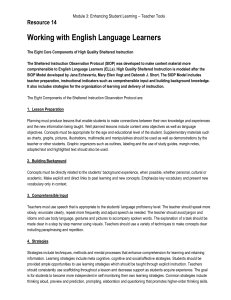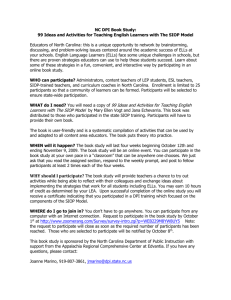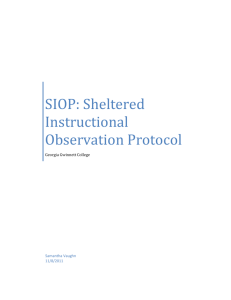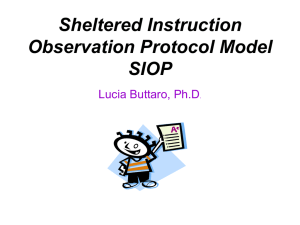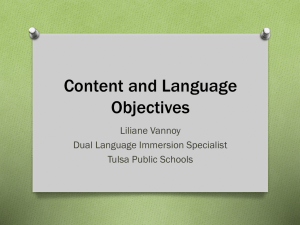Using the SIOP Model to Help ALL Students Succeed
advertisement
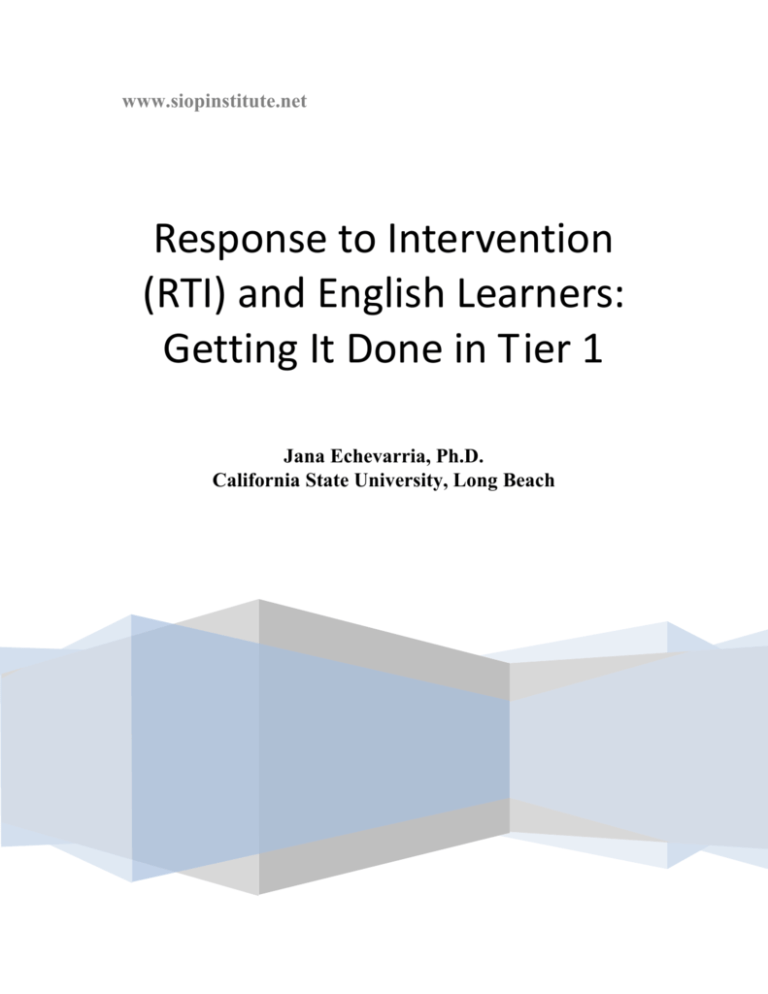
www.siopinstitute.net Response to Intervention (RTI) and English Learners: Getting It Done in Tier 1 Jana Echevarria, Ph.D. California State University, Long Beach The Sheltered Instruction Observation Protocol (SIOP) Echevarria, Vogt & Short, 2008; 2010 Components of the SIOP Model: Lesson Preparation – language and content objectives Building Background – vocabulary development, student connections Comprehensible Input – ESL techniques Strategies – metacognitive and cognitive learning strategies, scaffolding Interaction – oral language Practice & Application – practice all 4 language skills Lesson Delivery – meet objectives Review & Assessment – review vocabulary and concepts From: Echevarria, J. & Vogt, M. (2011) RTI and English learners: Making It Happen. Boston: Allyn & Bacon 2 RTI and ELs: TRUE OR FALSE??? 1. The purpose of RTI is to identify students for special education services. 2. RTI intervention is a curriculum. 3. Emphasis is on what the teacher needs to do to make the student successful in general education. 4. Approximately 70% of English learners may qualify for intervention. 5. The core components of RTI include research-based instruction and intervention, progress monitoring and assessments, collaboration with staff and parents to ensure data-driven decision making, and identification of learning disabilities. 6. When English learners struggle academically, we should wait for months before taking action. 7. The RTI teacher is responsible for making it work. 8. RTI is a recursive process. Students move in and out of intervention based on need. 9. If English learners are unsuccessful in general education, classroom instruction should be examined and support provided for the teacher. 3 Resources for Teaching English Learners Jana Echevarria, Ph.D. Research Resources: August, D. & Shanahan, T. (Eds.) (2006). Developing literacy in second-language learners: A report of the National Literacy Panel on Language-Minority Children and Youth. Mahwah, NJ: Lawrence Erlbaum Associates. California Department of Education (2010). Improving Education for English Learners: Research-Based Approaches. Sacramento, CA: CDE Press. Echevarria, J. & Short, D. (2011). The SIOP Model: A professional development framework for a comprehensive school-wide intervention. Washington, DC: Center for Research on the Educational Achievement and Teaching of English Language Learners. Retrieved from http://www.cal.org/create/resources/pubs/ Echevarria, J., Richards, C., Canges, R., & Francis, D. (In press). Using the SIOP Model to promote the acquisition of language and science concepts with English learners. Bilingual Research Journal. Echevarria, J., Richards-Tutor, C., Chinn, V., & Ratleff, P. (2011). Did they get it? The role of fidelity in teaching English learners. Journal of Adolescent and Adult Literacy. 54 (6) 425-434. Echevarria , J. & Short, D. (2010). Programs and practices for effective sheltered content instruction. In California Department of Education (Ed.). Improving education for English learners: Research-based approaches. (p. 250-321). Sacramento, CA: CDE Press. Echevarria, J., Short, D., & Powers, K. (2006). School reform and standards-based education: An instructional model for English language learners. Journal of Educational Research 99 (4), 195-210. Genesee, Lindholm-Leary, Saunders & Christian (2006). Educating English language learners: A synthesis of research evidence. New York: Cambridge University Press. Goldenberg, C. (2008). Teaching English language learners: What the research does – and does not – say. American Educator 12 (2), 8-22. Retreived from http://www.aft.org/pubs-reports/american_educator/issues/summer08/goldenberg.pdf Himmel, J., Short, D.J., Richards, C., & Echevarria, J. (2009). Using the SIOP Model to improve middle school science instruction. Washington, DC: Center for Research on the Educational Achievement and Teaching of English Language Learners. Retrieved from http://www.cal.org/create/resources/pubs/siopscience.htm Shatz, M. & Wilkenson, L. (Eds.) (2010). The education of English language learners: Research to practice. New York: Guilford Press. Short, D., Echevarria, J., & Richards-Tutor, C. (2011). Research on academic literacy development in sheltered instruction classrooms. Language Teaching Research, 15(3), 363-380 Short, D., Fidelman, C., & Louguit, M.(in press). Developing academic language in English language learners through sheltered instruction. TESOL Quarterly. . Professional Development Resources: The SIOP Model (www.siopinstitute.net): 4 Core SIOP Texts: Echevarria, J., Short, D. & Peterson, C. (2012). Using the SIOP Model with Pre-K and Kindergarten English Learners. Boston: Allyn & Bacon. Echevarria, J., Vogt, M.E. & Short, D. (2010a). Making Content Comprehensible for Elementary English Learners: The SIOP® Model. Boston: Allyn & Bacon. Echevarria, J., Vogt, M.E. & Short, D. (2010b). Making Content Comprehensible for Secondary English Learners: The SIOP® Model. Boston: Allyn & Bacon. Echevarria, J., Vogt, M.E. & Short, D. (2008). Making Content Comprehensible for English Learners: The SIOP® Model, Third Edition. Boston: Allyn & Bacon. Additional SIOP Texts: Echevarria, J. Short, D. & Vogt, M. (2008). Implementing the SIOP® Model through Effective Professional Development and Coaching. Boston: Allyn & Bacon. Echevarria, J., Vogt, M.E., & Short, D. (2010). The SIOP Model for Teaching Mathematics to English Learners. Boston: Allyn & Bacon. Short, D., Echevarria, J. & Vogt, M. (2008). The SIOP® Model for Administrators. Boston: Allyn & Bacon. Short, D., Vogt, M.E., & Echevarria, J. (2010). The SIOP Model for Teaching Science to English Learners. Boston: Allyn & Bacon. Short, D., Vogt, M.E., & Echevarria, J. (2011). The SIOP Model for Teaching History-Social Studies to English Learners. Boston: Allyn & Bacon. Vogt, M.E., & Echevarria, J. (2008). 99 Ideas and Activities for Teaching English Learners with the SIOP® Model. Boston: Allyn & Bacon. Vogt, M.E., Echevarria, J., & Short, D. (2010). The SIOP Model for Teaching EnglishLanguage Arts to English Learners. Boston: Allyn & Bacon. Teaching English Learners with Learning Challenges: Artiles, A. & Ortiz, A. (2007). English language learners with special education needs. Washington, DC: Center for Applied Linguistics. Echevarria, J. & Vogt, M. (2011) RTI and English learners: Making It Happen. Boston: Allyn & Bacon. Echevarria, J. & Vogt, M. (2010) Using the SIOP Model to improve literacy for English learners. New England Reading Association Journal (NERAJ). 46 (1) 8-15. Echevarria, J. & Graves, A. (2010). Sheltered Content Instruction: Teaching English Learners with Diverse Abilities, Fourth Edition. Boston: Allyn & Bacon. Echevarria, J., & Hasbrouck, J. (2009). Response to intervention and English learners (CREATE Brief). Washington, DC: Center for Research on the Educational Achievement and Teaching of English Language Learners. Retrieved from http://www.cal.org/create/resources/pubs/responsetointerv.html Esparza Brown, J., & Sanford, A. (March 2011). RTI for English Language Learners: Appropriately Using Screening and Progress Monitoring Tools to Improve Instructional Outcomes.U.S. Department of Education, Special Education Programs, National Center on Response to Intervention. 5 Haager, D., Klinger, J. & Vaughn, S. (2007). Evidence-based reading practices for response to intervention. Baltimore: Paul H. Brookes Publishing Co. Richards, C. & Leafstedt, J. (2010). Early reading intervention: Strategies and methods for struggling readers. Boston: Allyn & Bacon. Vogt, M.E. (In press). English learners: Developing their literate lives. In R. Bean & A. Dagen (Eds.), Best Practices of Literacy Leaders. New York: Guilford. Websites: National Center for Learning Disabilities - http://www.ncld.org/ National Center on Response to Intervention - http://www.rti4success.org National Center on Student Progress Monitoring - http://www.studentprogress.org 6
